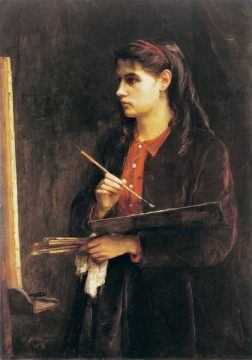Julian Barnes at the LRB:

In 1865-68, Edma had painted a portrait of her sister: standing at the easel, brush in hand, in fiercely concentrating profile. It is a remarkably talented work, both as a character portrayal and as a construction. Berthe is wearing a plum-brown velvet coat over which her dark brown hair falls; underneath, there is a red blouse whose colour is picked up in her thin red headband. The tonality is generally dark, except for two fierce slashes of light. On the extreme left of the picture, the illuminated edge of Berthe’s canvas descends at a slight angle to the vertical. In the centre, a broader fall of light at the opposite angle illuminates a determined face, three white shirt buttons, the fingers of a painting hand and the whiteness of a dangling rag; it also falls, more discreetly, on the tip of her brush and the thin edge of her palette. The picture is rightly placed at the start of the Musée d’Orsay show, and has a double poignancy: internally, because it allows us to discern the strength of character which will make Berthe Morisot a true artist, even though she herself can’t. But also externally, because it is one of only two pictures by Edma to survive. At some point, and with what motivation we can only guess, she destroyed all her work except for this canvas and a landscape. The assertion of unfulfilled talent can often sound a little theoretical; but there is further evidence. In late 1873 Degas, who was helping to organise the First Impressionist Exhibition, wrote to Mme Morisot to seek her help in persuading Berthe to contribute: ‘We think Mlle Berthe Morisot’s name and talent are too important to us to do without,’ he writes.
more here.
